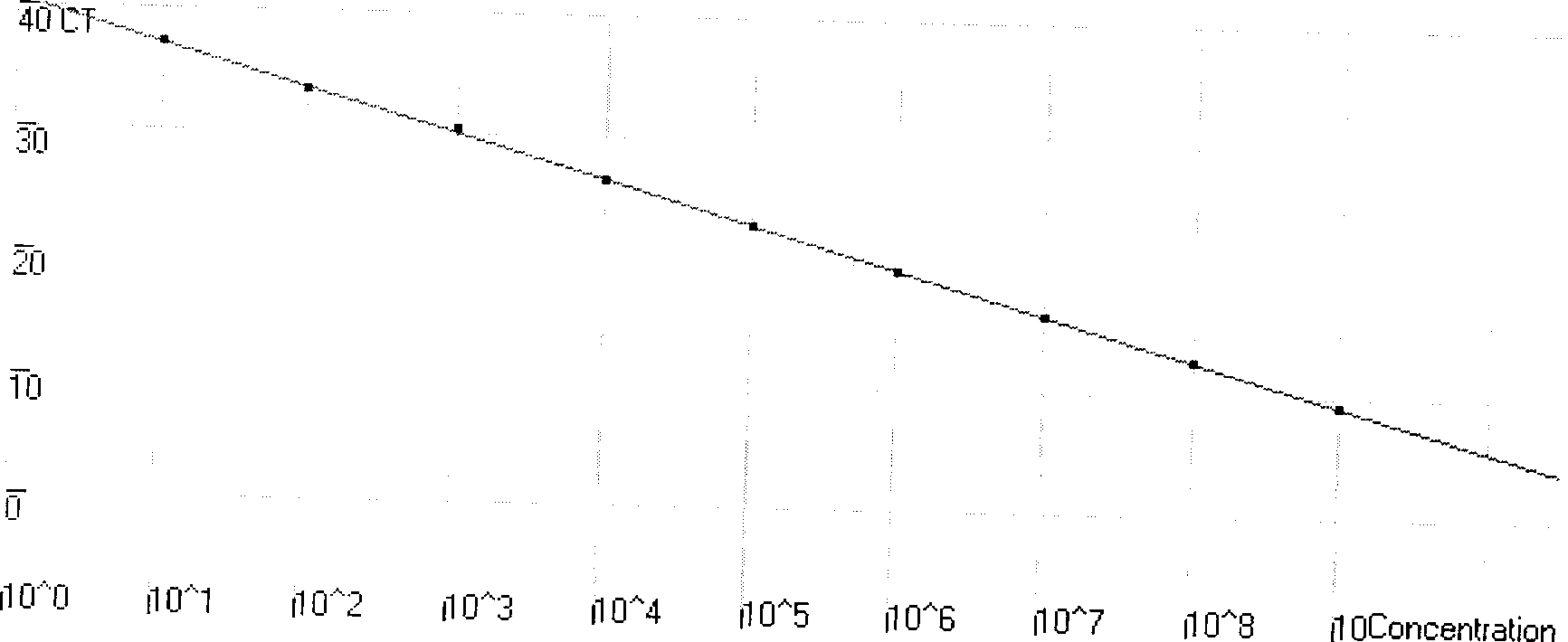Single cell real time fluorescent quantitative RT-PCR method for detecting foot-and-mouth disease virus genome RNA
A real-time fluorescent quantitative, foot-and-mouth disease virus technology, applied in biochemical equipment and methods, microbial determination/inspection, etc., can solve the problems of cumbersome, multiple operation steps, increase reaction time and error probability, etc.
- Summary
- Abstract
- Description
- Claims
- Application Information
AI Technical Summary
Problems solved by technology
Method used
Image
Examples
Embodiment 1
[0041] Example 1 Single-cell fluorescence quantitative RT-PCR detects the copy number of foot-and-mouth disease virus genome RNA in acutely infected cells
[0042] 1. Experimental reagents and instruments
[0043] A) Reagents
[0044] a) Trypsin, MEM medium, fetal bovine serum (all purchased from Invitrogen Company)
[0045] b) Cell stock solution: Each tube contains 5-10 μl 0.9% NaCl, which is divided into PCR tubes
[0046] c) Liquid nitrogen
[0047] d) Proteinase K and RNase inhibitors (purchased from Amesco and TAKARA companies respectively)
[0048] e) One-step reaction kit (including reverse transcriptase and hot-start Taq DNA polymerase and buffer), bovine serum albumin, RNase inhibitor, RNase-free water. The former two were purchased from Invitrogen, and the latter two were purchased from TAKARA.
[0049] f) RT, FP primers, probes (synthesized by Invitrogen)
[0050] g) Trizol cell lysate (purchased from Invitrogen)
[0051] B) Instrument
[0052] a) Microinje...
Embodiment 2
[0078] Example 2 Single-cell fluorescent quantitative RT-PCR detects the copy number of foot-and-mouth disease virus genome RNA in persistently infected cells
[0079] 1. Materials
[0080] A) Acquisition of BHK-21 cells persistently infected with foot-and-mouth disease virus: establishment of persistently infected cells by weak base method (rapid selection and characteristics research of cell lines persistently infected with foot-and-mouth disease virus Gu Chaojiang, Chinese Virology, Volume 18, No. 5 Issue 2003).
[0081] B) Reagents and instruments
[0082] a) Trypsin, MEM medium, fetal bovine serum (all purchased from Invitrogen Company)
[0083] b) Cell stock solution: each tube is filled with 5-10 μl 0.9% NaCl, and divided into PCR tubes
[0084] c) Liquid nitrogen
[0085] d) Proteinase K and RNase inhibitors (purchased from Amesco and TAKARA companies respectively)
[0086] e) One-step reaction kit (including reverse transcriptase and hot-start Taq DNA polymerase ...
Embodiment 3
[0110] Example 3 Application of separation and cracking single cell technology in single cell RT-PCR
[0111] 1. Reagents and instruments
[0112] a) Trypsin, MEM medium, fetal bovine serum (all purchased from Invitrogen Company)
[0113] b) Cell stock solution: each tube is filled with 5-10 μl 0.9% NaCl, and divided into PCR tubes
[0114] c) Liquid nitrogen
[0115] d) Proteinase K and RNase inhibitors (purchased from Amesco and TAKARA companies respectively)
[0116] e) RT reaction solution: M-MLV reverse transcriptase, 5× buffer, dNTP, RNase inhibitor. The former two were purchased from Promega Company, and the latter two were purchased from TAKARA Company.
[0117] f) PCR reaction solution: PremixTaq enzyme, sterile water. Purchased from TAKARA company.
[0118] g) RT, FP primers (synthesized by Invitrogen)
[0119] h) microinjector (purchased from Narashige company)
[0120] i) PCR instrument (purchased from Biometra company)
[0121] 2. Experimental method and ...
PUM
| Property | Measurement | Unit |
|---|---|---|
| diameter | aaaaa | aaaaa |
Abstract
Description
Claims
Application Information
 Login to View More
Login to View More - R&D
- Intellectual Property
- Life Sciences
- Materials
- Tech Scout
- Unparalleled Data Quality
- Higher Quality Content
- 60% Fewer Hallucinations
Browse by: Latest US Patents, China's latest patents, Technical Efficacy Thesaurus, Application Domain, Technology Topic, Popular Technical Reports.
© 2025 PatSnap. All rights reserved.Legal|Privacy policy|Modern Slavery Act Transparency Statement|Sitemap|About US| Contact US: help@patsnap.com



